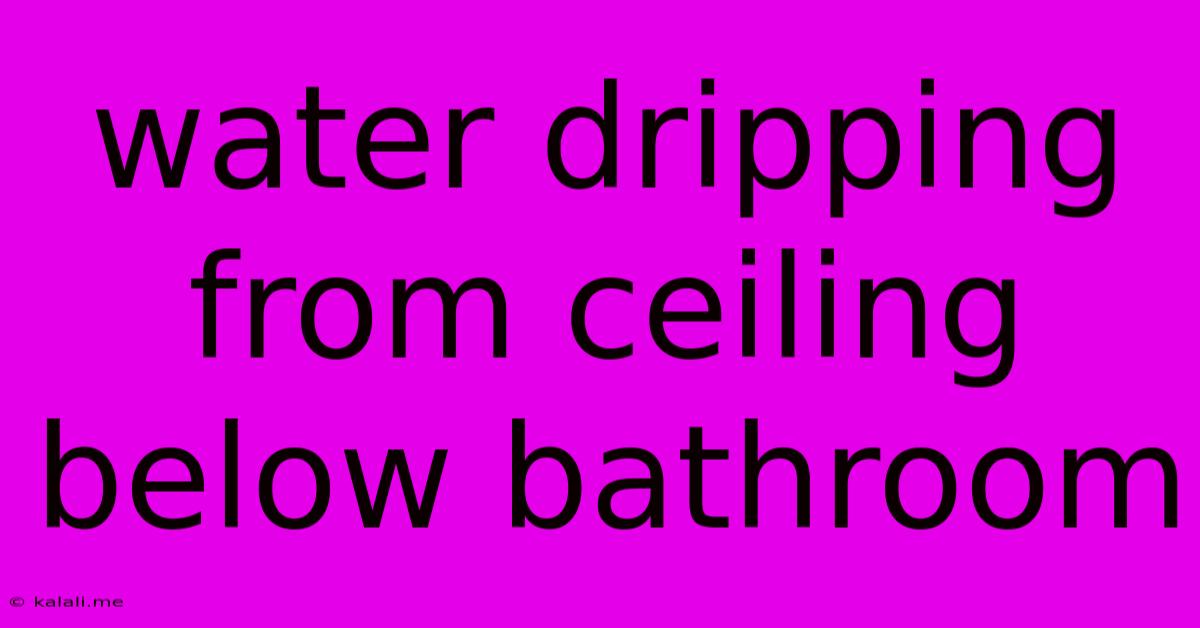Water Dripping From Ceiling Below Bathroom
Kalali
May 19, 2025 · 3 min read

Table of Contents
Water Dripping from the Ceiling Below the Bathroom: Causes and Solutions
A persistent drip from your ceiling, especially one located below the bathroom, is a significant problem that demands immediate attention. Ignoring it can lead to more extensive water damage, mold growth, and costly repairs. This article will explore the common causes of this issue and provide practical solutions to help you identify and fix the problem. Understanding the source is key to preventing future leaks and protecting your home's structure.
Why is my ceiling leaking below the bathroom? This is a common question with several possible answers. The most frequent culprits are plumbing issues within the bathroom itself.
Common Causes of Bathroom Ceiling Leaks
-
Leaking Pipes: This is often the primary culprit. Pipes carrying hot and cold water, as well as those connected to your shower, bathtub, or toilet, can corrode, crack, or become loose over time, leading to leaks. These leaks might be slow and subtle initially, only manifesting as a drip from the ceiling below. Look for signs of rust or discoloration around pipes.
-
Faulty Shower or Tub Surround: Cracks or gaps in the caulking around your shower or bathtub can allow water to seep through the walls and into the ceiling below. Regular inspection and caulking maintenance are crucial to prevent this. Consider the type of shower surround material—some are more prone to water damage than others.
-
Clogged or Leaking Drain: A slow-draining shower or bathtub can lead to water backing up and seeping through cracks or gaps in the plumbing system. Check for signs of a slow drain or water pooling around the base of the fixture.
-
Toilet Issues: While less frequent, a running toilet or a leak in the toilet tank or supply line can also contribute to water damage in the ceiling. Check for any signs of moisture around the toilet base or any unusual sounds indicating a leak.
-
Condensation: In certain climates or poorly ventilated bathrooms, condensation buildup on pipes can drip onto the ceiling below. This is more likely a minor issue resulting in dampness rather than a significant leak. Improved ventilation can usually resolve this.
Troubleshooting and Repairing the Leak
1. Identify the Source: The first step is to pinpoint the exact location of the leak. Carefully inspect the bathroom for any signs of water damage, such as discoloration, bulging drywall, or damp areas. Check around plumbing fixtures and look for any signs of leaks. If the leak seems to be originating from the shower or tub area, you might need to remove the shower surround or bathtub to get a clearer view.
2. Access the Affected Area: Depending on the source of the leak, you may need to access the area above the ceiling. This could involve removing ceiling tiles or drywall. It's important to be cautious and take necessary safety precautions, including turning off the water supply to the bathroom if necessary.
3. Repair the Leak: Once the source of the leak has been identified, it can be repaired. Depending on the extent of the problem, you may be able to fix it yourself or you might need to call a qualified plumber. Simple repairs, such as recaulking or tightening loose pipes, can be done with basic tools. More significant repairs, such as replacing damaged pipes or sections of the shower surround, should be left to a professional.
4. Dry Out the Affected Area: Once the leak is repaired, it's crucial to dry out the affected area thoroughly. This helps prevent the growth of mold and mildew. Use fans, dehumidifiers, or other drying methods to remove excess moisture.
5. Prevent Future Leaks: Regularly inspect your bathroom for signs of leaks or water damage. Caulk around fixtures as needed and make sure to address any minor problems promptly. Maintain good ventilation in your bathroom to minimize condensation buildup.
Ignoring a leaking ceiling can lead to serious problems, including structural damage and mold growth. Taking proactive steps to identify and fix the leak is crucial to protecting your home and ensuring the safety of its inhabitants. If you're unsure about how to handle the repair, always consult a qualified plumber or contractor.
Latest Posts
Latest Posts
-
How Long Should Mortar Cure Before Putting Weight On It
May 19, 2025
-
I Speak A Little In German
May 19, 2025
-
How To Make Grass Grow Minecraft
May 19, 2025
-
Why Are My Lights Flickering In One Room
May 19, 2025
-
What Is The Plural For Roof
May 19, 2025
Related Post
Thank you for visiting our website which covers about Water Dripping From Ceiling Below Bathroom . We hope the information provided has been useful to you. Feel free to contact us if you have any questions or need further assistance. See you next time and don't miss to bookmark.